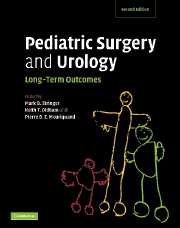Book contents
- Frontmatter
- Contents
- List of contributors
- Acknowledgments
- Preface
- Part I General issues
- Part II Head and neck
- Part III Thorax
- Part IV Abdomen
- 20 Abdominal surgery: general aspects
- 21 Abdominal wall defects
- 22 Inguinal and umbilical hernias
- 23 Infantile hypertrophic pyloric stenosis
- 24 Small bowel disorders
- 25 Cystic fibrosis
- 26 Necrotizing enterocolitis
- 27 Inflammatory bowel disease in children
- 28 Intestinal failure
- 29 Appendicitis
- 30 Hirschsprung's disease
- 31 Anorectal malformations: experience with the posterior sagittal approach
- 32 Gastrointestinal motility disorders
- 33 The Malone antegrade continence enema (MACE) procedure
- 34 Splenectomy
- 35 Biliary atresia
- 36 Choledochal cyst
- 37 Biliary stone disease
- 38 Portal hypertension
- 39 Persistent hyperinsulinemic hypoglycemia in infancy
- 40 Acute and chronic pancreatitis in children
- Part V Urology
- Part VI Oncology
- Part VII Transplantation
- Part VIII Trauma
- Part IX Miscellaneous
- Index
- Plate section
- References
26 - Necrotizing enterocolitis
from Part IV - Abdomen
Published online by Cambridge University Press: 08 January 2010
- Frontmatter
- Contents
- List of contributors
- Acknowledgments
- Preface
- Part I General issues
- Part II Head and neck
- Part III Thorax
- Part IV Abdomen
- 20 Abdominal surgery: general aspects
- 21 Abdominal wall defects
- 22 Inguinal and umbilical hernias
- 23 Infantile hypertrophic pyloric stenosis
- 24 Small bowel disorders
- 25 Cystic fibrosis
- 26 Necrotizing enterocolitis
- 27 Inflammatory bowel disease in children
- 28 Intestinal failure
- 29 Appendicitis
- 30 Hirschsprung's disease
- 31 Anorectal malformations: experience with the posterior sagittal approach
- 32 Gastrointestinal motility disorders
- 33 The Malone antegrade continence enema (MACE) procedure
- 34 Splenectomy
- 35 Biliary atresia
- 36 Choledochal cyst
- 37 Biliary stone disease
- 38 Portal hypertension
- 39 Persistent hyperinsulinemic hypoglycemia in infancy
- 40 Acute and chronic pancreatitis in children
- Part V Urology
- Part VI Oncology
- Part VII Transplantation
- Part VIII Trauma
- Part IX Miscellaneous
- Index
- Plate section
- References
Summary
Introduction
For more than 30 years, necrotizing enterocolitis (NEC) has been the most common surgical emergency in the neonatal intensive care unit (NICU). Despite decades of clinical advances and research, the management of NEC continues to pose a significant challenge to the pediatric surgeon. Currently, NEC is the major cause of death for all neonates undergoing surgery with a surgical mortality rate of 20–60%. The mortality from this disease is greater than that from all of the congenital anomalies of the gastrointestinal tract combined. Infants who do survive may be plagued by the chronic condition of short-bowel syndrome, with its associated complications of total parenteral nutrition and the possible need for liver and/or intestinal transplantation. Additionally, infants surviving necrotizing enterocolitis may have significant long-term gastrointestinal, growth and neurodevelopmental sequelae.
Epidemiology
Necrotizing enterocolitis affects 1–3 in 1000 live births and up to 8% of NICU admissions. In 2001, NEC was the tenth leading cause of neonatal deaths. As advances in neonatology and the modern intensive care unit have led to the increased survival of smaller and younger infants, the number of babies at risk for NEC and, therefore, the incidence has increased.
During the last 20 years, the infant mortality rate attributable to NEC increased from an average of 11.5 per 100000 live births in the early 1980s to an average of 12.3 deaths per 100 000 live births during 1990–1992.
- Type
- Chapter
- Information
- Pediatric Surgery and UrologyLong-Term Outcomes, pp. 329 - 350Publisher: Cambridge University PressPrint publication year: 2006

